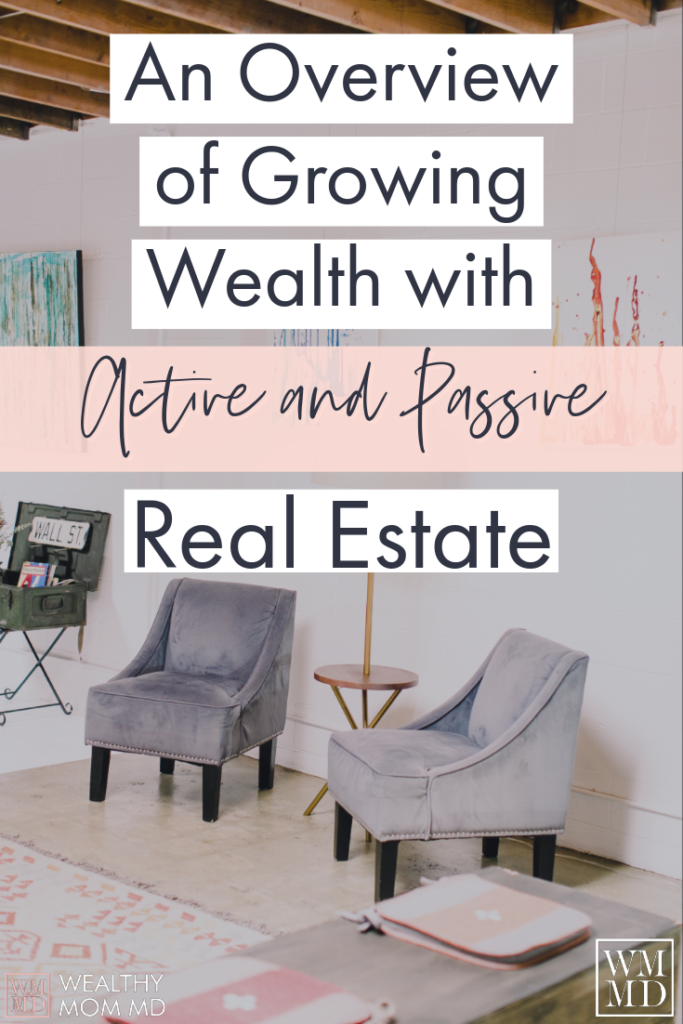If you’re looking to grow wealth, real estate should be part of your plan. Not convinced? Consider that Andrew Carnegie, the author of Think and Grow Rich, once said, “90% of all millionaires became so through owning real estate.” For many people, though, real estate seems too confusing or too much of a time commitment. If that’s the case, you need this overview on real estate to learn how both active and passive real estate might play a role in your overall investment plan.
An Overview of Active and Passive Real Estate
There’s a good chance you’ve heard at least someone in your life (or on this blog!) mention the value of real estate investments. Perhaps you are interested but unsure, or maybe you’ve been avoiding it. What’s more likely, though, is that you don’t currently invest in real estate because you aren’t sure how to get started.
The goal of this real estate overview is to explore enough of the benefits that you feel empowered to explore more. As an added benefit, we’ll take a deeper dive into passive real estate to see how this is something that can fit into your busy life and wealth-building plans.
The Benefits of Real Estate
Whether you’re involved in active or passive real estate, it’s important to understand the benefits. Here is a general overview of four of the greatest benefits of investing in real estate.
Speed
Perhaps the biggest benefit of real estate is the speed at which you can generate income. Real estate allows investors to make money relatively quickly compared to stock market investing. Between waiting for returns to compound and paying taxes, growing wealth through the stock market takes time. Real estate, on the other hand, can pay off much quicker.
Taxes
Some traditional stock market investments can be tax sheltered, but there’s no getting around the fact that you may pay quite a bit in taxes on your investments. Conversely, you reap the best and most tax benefits as a real estate investor. This is especially true if you achieve real estate professional status. Here’s a secret–the tax code is written for real estate investors and generally “punishes” employees.
Familiarity
Another important consideration to make when getting started with real estate investing is the fact that you’re already familiar with it. Even if you rent your home now, you’ve still encountered the notion of home ownership. Because there are so many different types of real estate–more on that in a bit!–if you’ve actually lived in different dwellings, you have even more familiarity with this type of investing than you probably realize.
Tangible asset
Finally, real estate is a tangible asset. You can see the property that you own. This is vastly different than numbers on a screen that relate to shares of a company that you might own via the stock market. For some people, the fact that this is a tangible asset actually makes people feel more confident.
How Real Estate Makes You Money
There are several different ways that real estate makes you money. When you’re deciding between active and passive real estate (or maybe considering doing some of both), it’s important to have at least a surface-level understanding of how wealth is generated.
- Cash flow – If you own direct real estate, and the rent you are paid is more than your mortgage and other expenses, you’ve created cash flow.
- Appreciation – Generally speaking, real estate appreciates over time. That means that the value of your investment should hopefully continue to increase.
- Tax benefits – There are numerous tax benefits, such as the real estate professional status, that are only afforded to real estate investors.
- Leverage – Someone who is leveraging is using borrowed money to make more money. This is a novel concept to many since many of us would not otherwise consider taking on debt to make money.

Types of Real Estate
Houses are probably the most common type of real estate that people think of. However, there are actually many types of real estate you can invest in.
Some types of real estate include:
- Raw land
- Single-family homes (this is the traditional home that you probably live in now)
- Multiple-family homes, such as duplexes or triplexes
- Apartment complexes
- Mobile homes
- Commercial real estate
- Self-storage facilities
Equity and Debt Investing
You can think of real estate investing in two ways: equity and debt. By understanding the two ways that you can invest in real estate, you’ll be a much more informed investor.
Equity
An equity investment in real estate is when you own the property. This can take on many different forms. In the case of direct ownership, you own the property that you then rent out.
Additionally, you can also invest in syndications, crowdfunding, or real estate investment trusts (REITs). When done in this manner, investors profit from the promised interest return and then again with a share of the profit when the properties are sold.
Debt
If you’re familiar with how bonds work, you can think of debt investing in real estate as something similar to that. You lend money to another person or entity so that they can buy real estate. As an investor, you will typically receive monthly interest payments. These interest rates can be quite high, especially compared to bonds. After a period of time, usually a year, your capital is then returned. The high interest rates plus the fact that they are simple and relatively secure make debt investing powerful.
It is important to remember that debt investing is taxed as ordinary income. The only exception to that would be if you are buying them inside a tax-advantaged account. To do that, you would need to set up a self-directed IRA. By creating a self-directed IRA, the account custodians will then allow you to invest in a debt fund, and the money in the account is tax sheltered.
Looking at the Spectrum: From Active to Passive Real Estate
Direct ownership is the most active type of real estate investing. For some people, the fact that direct ownership also comes with the most tax benefits thanks to that real estate professional status is enough to justify the work that often goes into direct ownership.
However, there is a good chance that you’re looking to build more passive streams of income. Whether you are thinking of real estate as a side hustle, a secondary income stream, or even an opportunity to downshift from your full-time medical practice, it’s important to understand the more passive options.
Turnkey real estate is less work than direct ownership but you still fully own the property. In this process, an investor is still buying and possibly rehabbing a property, but they use a third-party to make it more hands-off.
Even more passive than turnkey real estate are syndications. Syndications pool funds from a group of investors into various real estate projects, generally projects that a single investor would not be able to buy on their own (think multi-million dollar projects).
Finally, crowd-funding and real estate funds are the most passive types of real estate investing. You should know that they are the most passive, and they also come with the fewest tax benefits.
A Deeper Dive into Passive Investing
The idea of diversifying your portfolio with real estate sounds appealing to most people. However, it’s true that active real estate can sometimes feel like another full-time job. If you want something more hands-off, you’ll want to explore some of the more passive real estate investing options.
Crowdfunding
If you’re familiar with the concept of crowdfunding in terms of ideas or products (think Kickstarter), you already have an understanding of how crowdfunding real estate works. Crowdfunding real estate is fairly new, at least in a formal capacity. However, investors have been pooling funds for centuries.
In crowdfunding real estate, investors combine their resources to invest in any variety of real estate projects. Online platforms streamline the crowdfunding process further. That way, investors can bypass the parts of active real estate–working with agents, brokers, and contractors–that can be so time consuming.
Real estate crowdfunding can involve both debt and equity deals.
Syndications
Recall that a real estate syndication pulls together funding from multiple investors. This pool is then used to purchase a larger real estate project. Typically, the investments including properties like high-rise apartment buildings, assisted living facilities, or self-storage centers. By pooling money together, the expenses are shared and the risk is split.
REITs
A real estate investment trust, also known as a REIT, is another form of passive real estate investing. Generally, the trust purchases a property and rents the space. The income that is generated from the rental is returned to shareholders in the form of dividends. You can purchase shares of a REIT through a brokerage, like Vanguard or Fidelity.
Final Thoughts on Active and Passive Real Estate
You aren’t likely to become an expert investor after reading one blog post. But consider working through this overview of active and passive real estate a crucial first step to growing wealth via real estate. Next week, I’ll go more in depth about syndications.
If you’re ready to take the next step with passive real estate investing, check out Dr. Peter Kim’s Passive Real Estate Academy. In this 4 week online course he will teach you everything you need to know to vet and analyze a syndication deal so you can be confident investing in it. As a special bonus to my readers, if you purchase through me, you will receive two books: Rich Dad, Poor Dad by Robert Kiyosaki and How to Invest in Real Estate: The Ultimate Beginner’s Guide to Getting Started by Bigger Pockets.
Disclaimer: Please note that some of the links below are affiliate links. This means that I may receive a commission if you purchase through one of my links. I highly recommend all of the products & services because they are companies that I have found to be helpful and trustworthy. I use many of these products & services myself.

Get the bestselling book - Defining Wealth for Women.



